Mean Temperature and Drought Projections in Central Africa: A Population-Based Study of Food Insecurity, Childhood Malnutrition and Mortality, and Infectious Disease
Abstract
1. Introduction
2. Materials and Methods
- 1.
- Undernourishment: The proportion of the population with inadequate calorie intake.
- 2.
- Child stunting: The proportion of under-five children with a low height for age (HAZ), indicating chronic undernutrition.
- 3.
- Child wasting: The proportion of under-five children with low weight for height (W/H), indicating acute undernutrition.
- 4.
- Child mortality: The percentage of children who die before the age of 5, indicating unhealthy environments and inadequate nutrition.
3. Results
3.1. Food Insecurity in the Central African Region
3.2. Malnutrition Indicators and Trends in the Central African Region
3.2.1. Global Hunger Index (GHI)
3.2.2. Undernourishment, Wasting and Stunting, and Under-Five Mortality
3.3. Indicators of Infectious Disease
3.3.1. AROC of Mortality Due to Diarrhea between 2000 and 2015
3.3.2. Pneumonia Mortality Rates by Age between 1990 and 2019
3.4. Statistical Trends of Air Temperature Changes and Drought Outcomes through 2100
3.4.1. Statistical Reporting of Temperature Change Predictions between 2030 and 2100
3.4.2. Statistical Reporting of SPEI Drought Index Projections between 2030 and 2100
4. Discussion
4.1. Limitations
4.2. Recommendations
5. Conclusions
Author Contributions
Funding
Institutional Review Board Statement
Informed Consent Statement
Data Availability Statement
Conflicts of Interest
References
- Mehler, A. Central Africa: Regional Politics and Dynamics. In Oxford Research Encyclopedia of Politics; Oxford University Press: Oxford, UK, 2019. [Google Scholar]
- Mayaux, P.; Richards, T.; Janodet, E. A Vegetation Map of Central Africa Derived from Satellite Imagery. J. Biogeogr. 1999, 26, 353–366. [Google Scholar] [CrossRef]
- Kubik, G. Central Africa: An Introduction. In The Garland Handbook of African Music; Routledge: Abingdon-on-Thames, UK, 2010; pp. 328–361. ISBN 0203927877. [Google Scholar]
- Ochieng, J.; Knerr, B.; Owuor, G.; Ouma, E. Food Crops Commercialization and Household Livelihoods: Evidence from Rural Regions in Central Africa. Agribusiness 2020, 36, 318–338. [Google Scholar] [CrossRef]
- Conte, B.; Desmet, K.; Nagy, D.K.; Rossi-Hansberg, E. Local Sectoral Specialization in a Warming World. J. Econ. Geogr. 2021, 21, 493–530. [Google Scholar] [CrossRef]
- Osabohien, R.; Matthew, O.; Gershon, O.; Ogunbiyi, T.; Nwosu, E. Agriculture Development, Employment Generation and Poverty Reduction in West Africa. Open Agric. J. 2019, 13, 82–89. [Google Scholar] [CrossRef]
- Mehrmal, S.; Uppal, P.; Nedley, N.; Giesey, R.L.; Delost, G.R. The Global, Regional, and National Burden of Psoriasis in 195 Countries and Territories, 1990 to 2017: A Systematic Analysis from the Global Burden of Disease Study 2017. J. Am. Acad. Dermatol. 2021, 84, 46–52. [Google Scholar] [CrossRef]
- World Health Organisation. Atlas of African Health Statistics 2018: Universal Health Coverage and the Sustainable Development Goals in the WHO African Region; World Health Organisation: Geneva, Switzerland, 2018. [Google Scholar]
- Foreman, K.J.; Marquez, N.; Dolgert, A.; Fukutaki, K.; Fullman, N.; McGaughey, M.; Pletcher, M.A.; Smith, A.E.; Tang, K.; Yuan, C.-W. Forecasting Life Expectancy, Years of Life Lost, and All-Cause and Cause-Specific Mortality for 250 Causes of Death: Reference and Alternative Scenarios for 2016–40 for 195 Countries and Territories. Lancet 2018, 392, 2052–2090. [Google Scholar] [CrossRef]
- Cerf, M.E. The Sustainable Development Goals: Contextualizing Africa’s Economic and Health Landscape. Glob. Challenges 2018, 2, 1800014. [Google Scholar] [CrossRef] [PubMed]
- Juma, K.; Wekesah, F.M.; Kabiru, C.W.; Izugbara, C.O. Burden, Drivers, and Impacts of Poor Mental Health in Young People of West and Central Africa: Implications for Research and Programming. In West African Youth Challenges and Opportunity Pathways; Palgrave Macmillan: Cham, Switzerland, 2020; pp. 233–265. [Google Scholar]
- Dhrifi, A. Health-Care Expenditures, Economic Growth and Infant Mortality: Evidence from Developed and Developing Countries. CEPAL Rev. 2019, 69, 125. [Google Scholar] [CrossRef]
- Vilakazi, N.; Nyirenda, K.; Vellemu, E. Unlocking Water Issues towards Food Security in Africa. In Food Security in Africa; IntechOpen: London, UK, 2019; ISBN 1789857341. [Google Scholar]
- Wiebe, K.; Robinson, S.; Cattaneo, A. Climate Change, Agriculture and Food Security: Impacts and the Potential for Adaptation and Mitigation. In Sustainable Food and Agriculture: An Integrated Approach; Campanhola, C., Pandey, S., Eds.; Academic Press, Elsevier: Cambridge, MA, USA, 2019; pp. 55–74. [Google Scholar]
- Adenle, A.A.; Azadi, H.; Manning, L. The Era of Sustainable Agricultural Development in Africa: Understanding the Benefits and Constraints. Food Rev. Int. 2018, 34, 411–433. [Google Scholar] [CrossRef]
- Serraj, R.; Krishnan, L.; Pingali, P. Agriculture and Food Systems to 2050: A Synthesis. Agric. Food Syst. 2019, 2050, 3–45. [Google Scholar]
- Iyakaremye, V.; Zeng, G.; Yang, X.; Zhang, G.; Ullah, I.; Gahigi, A.; Vuguziga, F.; Asfaw, T.G.; Ayugi, B. Increased High-Temperature Extremes and Associated Population Exposure in Africa by the Mid-21st Century. Sci. Total Environ. 2021, 790, 148162. [Google Scholar] [CrossRef]
- Wang, Y.-R.; Hessen, D.O.; Samset, B.H.; Stordal, F. Evaluating Global and Regional Land Warming Trends in the Past Decades with Both MODIS and ERA5-Land Land Surface Temperature Data. Remote Sens. Environ. 2022, 280, 113181. [Google Scholar] [CrossRef]
- Alas, M. Malaria and Dengue: Understanding Two Infectious Diseases Affecting Developing Countries and Their Link to Climate Change; Research Paper; South Centre: Geneva, Switzerland, 2021. [Google Scholar]
- Islam, M.; Shahin, M.; Miraj, M.; Ghosh, S.; Islam, I. Climate Change Impacts and Mitigation Approach: Coastal Landscape, Transport, and Health Aspects. In Bangladesh II: Climate Change Impacts, Mitigation and Adaptation in Developing Countries; Springer: Cham, Switzerland, 2021; pp. 41–101. [Google Scholar]
- Gostin, L.O. Global Health Security: A Blueprint for the Future; Harvard University Press: Cambridge, MA, USA, 2021; ISBN 0674976614. [Google Scholar]
- Lombardi, D.; Rustomjee, C. The IMF’s Engagement on Natural Disasters and Climate Change Issues Affecting Small Developing States; IEO Background Paper No. BP/22-01/05; IMF: Washington, DC, USA, 2022. [Google Scholar]
- Acevedo, S.; Mrkaic, M.; Novta, N.; Pugacheva, E.; Topalova, P. The Effects of Weather Shocks on Economic Activity: What Are the Channels of Impact? J. Macroecon. 2020, 65, 103207. [Google Scholar] [CrossRef]
- Leal Filho, W.; Balogun, A.-L.; Olayide, O.E.; Azeiteiro, U.M.; Ayal, D.Y.; Muñoz, P.D.C.; Nagy, G.J.; Bynoe, P.; Oguge, O.; Toamukum, N.Y. Assessing the Impacts of Climate Change in Cities and Their Adaptive Capacity: Towards Transformative Approaches to Climate Change Adaptation and Poverty Reduction in Urban Areas in a Set of Developing Countries. Sci. Total Environ. 2019, 692, 1175–1190. [Google Scholar] [CrossRef]
- Raftery, A.E.; Zimmer, A.; Frierson, D.M.W.; Startz, R.; Liu, P. Less than 2 C Warming by 2100 Unlikely. Nat. Clim. Chang. 2017, 7, 637–641. [Google Scholar] [CrossRef]
- Achieng’, R.M. Can We Speak of African Agency?: APRM and Africa’s Agenda 2063. African Sociol. Rev. Africaine Sociol. 2014, 18, 49–64. [Google Scholar]
- Karuri-Sebina, G. Urban Africa’s Futures: Perspectives and Implications for Agenda 2063. Foresight 2020, 22, 95–108. [Google Scholar] [CrossRef]
- Antwi-Agyei, P.; Dougill, A.J.; Agyekum, T.P.; Stringer, L.C. Alignment between Nationally Determined Contributions and the Sustainable Development Goals for West Africa. Clim. Policy 2018, 18, 1296–1312. [Google Scholar] [CrossRef]
- Ouedraogo, N.S. Transition Pathways for North Africa to Meet Its (Intended) Nationally Determined Contributions ((I) NDCs) under the Paris Agreement: A Model-Based Assessment. Clim. Policy 2020, 20, 71–94. [Google Scholar] [CrossRef]
- Tshidzumba, A.; Olajide, B.; Ojakorotu, V. Climate Change and the Politics of Implementation of the Nationally Determined Contributions (NDCs) in Africa. J. Nation-Build. Policy Stud. 2020, 2020, 47. [Google Scholar]
- Boutayeb, A. The Impact of Infectious Diseases on the Development of Africa. Handb. Dis. Burd. Qual. Life Meas. 2010, 2010, 1171–1188. [Google Scholar]
- Fenollar, F.; Mediannikov, O. Emerging Infectious Diseases in Africa in the 21st Century. New Microbes New Infect. 2018, 26, S10–S18. [Google Scholar] [CrossRef]
- Abdul Jabbar, S.; Tul Qadar, L.; Ghafoor, S.; Rasheed, L.; Sarfraz, Z.; Sarfraz, A.; Sarfraz, M.; Felix, M.; Cherrez-Ojeda, I. Air Quality, Pollution and Sustainability Trends in South Asia: A Population-Based Study. Int. J. Environ. Res. Public Health 2022, 19, 7534. [Google Scholar] [CrossRef]
- Salman, H.M.; Syed, J.; Riaz, A.; Sarfraz, Z.; Sarfraz, A.; Bokhari, S.H.A.A.; Ojeda, I.C. An Epidemiological, Strategic and Response Analysis of the COVID-19 Pandemic in South Asia: A Population-Based Observational Study. BMC Public Health 2022, 22, 1–9. [Google Scholar]
- Haile, G.G.; Tang, Q.; Hosseini-Moghari, S.; Liu, X.; Gebremicael, T.G.; Leng, G.; Kebede, A.; Xu, X.; Yun, X. Projected Impacts of Climate Change on Drought Patterns over East Africa. Earth’s Futur. 2020, 8, e2020EF001502. [Google Scholar] [CrossRef]
- Ayugi, B.; Tan, G.; Niu, R.; Dong, Z.; Ojara, M.; Mumo, L.; Babaousmail, H.; Ongoma, V. Evaluation of Meteorological Drought and Flood Scenarios over Kenya, East Africa. Atmosphere 2020, 11, 307. [Google Scholar] [CrossRef]
- Canova, C.; Cantarutti, A. Population-Based Birth Cohort Studies in Epidemiology. Int. J. Environ. Res. Public Health 2020, 17, 5276. [Google Scholar] [CrossRef]
- World Health Organization (WHO) Climate Change. Available online: https://www.who.int/health-topics/climate-change#tab=tab_1 (accessed on 18 January 2023).
- IPC IPC Country Analysis. Available online: https://www.ipcinfo.org/ipc-country-analysis/en/ (accessed on 12 November 2022).
- Global Hunger Index Global, Regional, and National Trends—Global Hunger Index (GHI)—Peer-Reviewed Annual Publication Designed to Comprehensively Measure and Track Hunger at the Global, Regional, and Country Levels. Available online: https://www.globalhungerindex.org/trends.html (accessed on 13 November 2022).
- Roth, G.A. Global Burden of Disease Collaborative Network. Global Burden of Disease Study 2017 (GBD 2017) Results. Seattle, United States: Institute for Health Metrics and Evaluation (IHME), 2018. Lancet 2018, 392, 1736–1788. [Google Scholar] [CrossRef]
- Institute for Health Metrics and Evaluation (IHME). Africa Under-5 Diarrhea Incidence, Prevalence, and Mortality Geospatial Estimates 2000–2015; Institute for Health Metrics and Evaluation: Seattle, WA, USA, 2018. [Google Scholar]
- World Bank Group Climate Change Knowledge Portal. Available online: https://climateknowledgeportal.worldbank.org/ (accessed on 10 November 2022).
- Sixth Assessment Report—IPCC. Available online: https://www.ipcc.ch/assessment-report/ar6/ (accessed on 17 January 2023).
- Vicente-Serrano, S.M.; Beguería, S.; López-Moreno, J.I. A Multiscalar Drought Index Sensitive to Global Warming: The Standardized Precipitation Evapotranspiration Index. J. Clim. 2010, 23, 1696–1718. [Google Scholar] [CrossRef]
- Kurtz, A.; Grant, K.; Marano, R.; Arrieta, A.; Feaster, W.; Steele, C.; Ehwerhemuepha, L. Long-Term Effects of Malnutrition on Severity of COVID-19. Sci. Rep. 2021, 11, 1–8. [Google Scholar]
- Abate, H.K.; Kidane, S.Z.; Feyessa, Y.M.; Gebrehawariat, E.G. Mortality in Children with Severe Acute Malnutrition. Clin. Nutr. ESPEN 2019, 33, 98–104. [Google Scholar] [CrossRef] [PubMed]
- UNICEF West and Central Africa Malnutrition. Available online: https://www.unicef.org/wca/malnutrition (accessed on 12 November 2022).
- Zuñiga, R.A.A.; Lima, G.N.; Villoria, A.M.G. Impact of Slow-Onset Events Related to Climate Change on Food Security in Latin America and the Caribbean. Curr. Opin. Environ. Sustain. 2021, 50, 215–224. [Google Scholar] [CrossRef]
- Ariom, T.O.; Dimon, E.; Nambeye, E.; Diouf, N.S.; Adelusi, O.O.; Boudalia, S. Climate-Smart Agriculture in African Countries: A Review of Strategies and Impacts on Smallholder Farmers. Sustainability 2022, 14, 11370. [Google Scholar] [CrossRef]
- Tirivangasi, H.M.; Nyahunda, L. Challenges Faced by Rural People in Mitigating the Effects of Climate Change in the Mazungunye Communal Lands, Zimbabwe. Jàmbá J. Disaster Risk Stud. 2019, 11, 1–9. [Google Scholar]
- Kalele, D.N.; Ogara, W.O.; Oludhe, C.; Onono, J.O. Climate Change Impacts and Relevance of Smallholder Farmers’ Response in Arid and Semi-Arid Lands in Kenya. Sci. African 2021, 12, e00814. [Google Scholar] [CrossRef]
- Feyisa, A.S. Review of the Role of Orphan Crops in Food Security. Res. World Agric. Econ. 2022, 1, 321873. [Google Scholar] [CrossRef]
- Davis, K.F.; Downs, S.; Gephart, J.A. Towards Food Supply Chain Resilience to Environmental Shocks. Nat. Food 2021, 2, 54–65. [Google Scholar] [CrossRef]
- Rawlins, J.; Kalaba, F.K. Adaptation to Climate Change: Opportunities and Challenges from Zambia. African Handb. Clim. Chang. Adapt. 2020, 1–20. [Google Scholar]
- Nichols, G.; Lake, I.; Heaviside, C. Climate Change and Water-Related Infectious Diseases. Atmosphere 2018, 9, 385. [Google Scholar] [CrossRef]
- Vijayalakshmi, D.; Barbhai, M.D. Resilient Measures in Face of Climate Change to Strengthen Food and Nutritional Security. In Climate Change and Resilient Food Systems; Springer: Cham, Switzerland, 2021; pp. 113–140. [Google Scholar]
- Waddington, H.J. Broadening Horizons in Impact Evaluation for Water, Sanitation and Hygiene Planning: Recycling and Reinterpreting Evidence; London School of Hygiene & Tropical Medicine: London, UK, 2021. [Google Scholar]
- Brusseau, M.L.; Ramirez-Andreotta, M.; Pepper, I.L.; Maximillian, J. Environmental Impacts on Human Health and Well-Being. In Environmental and Pollution Science; Elsevier: Amsterdam, The Netherlands, 2019; pp. 477–499. [Google Scholar]
- Schoonees, A.; Lombard, M.J.; Musekiwa, A.; Nel, E.; Volmink, J. Ready-to-use Therapeutic Food (RUTF) for Home-based Nutritional Rehabilitation of Severe Acute Malnutrition in Children from Six Months to Five Years of Age. Cochrane Database Syst. Rev. 2019, 5. [Google Scholar] [CrossRef]
- Nikièma, V.; Kangas, S.T.; Salpéteur, C.; Ouédraogo, A.; Lachat, C.; Bassolé, N.H.I.; Fogny, N.F. Adequacy of Nutrient Intakes of Severely and Acutely Malnourished Children Treated with Different Doses of Ready-to-Use Therapeutic Food in Burkina Faso. J. Nutr. 2021, 151, 1008–1017. [Google Scholar] [CrossRef] [PubMed]
- Kangas, S.T.; Salpéteur, C.; Nikièma, V.; Talley, L.; Ritz, C.; Friis, H.; Briend, A.; Kaestel, P. Impact of Reduced Dose of Ready-to-Use Therapeutic Foods in Children with Uncomplicated Severe Acute Malnutrition: A Randomised Non-Inferiority Trial in Burkina Faso. PLoS Med. 2019, 16, e1002887. [Google Scholar] [CrossRef] [PubMed]
- Imdad, A.; Rogner, J.L.; François, M.; Ahmed, S.; Smith, A.; Tsistinas, O.J.; Tanner-Smith, E.; Das, J.K.; Chen, F.F.; Bhutta, Z.A. Increased vs. Standard Dose of Iron in Ready-to-Use Therapeutic Foods for the Treatment of Severe Acute Malnutrition in a Community Setting: A Systematic Review and Meta-Analysis. Nutrients 2022, 14, 3116. [Google Scholar] [CrossRef] [PubMed]
- Elwakil, R.; Elsahhar, M.; Fouad, Y.; Ocama, P.; Ng’wanassai, M. The Synergistic Impact of Climate Change and COVID-19 on Gut Health in Africa; National Research Repository of Uganda: Kampala, Uganda, 2021. [Google Scholar]
- Anderson, W.; Taylor, C.; McDermid, S.; Ilboudo-Nébié, E.; Seager, R.; Schlenker, W.; Cottier, F.; de Sherbinin, A.; Mendeloff, D.; Markey, K. Violent Conflict Exacerbated Drought-Related Food Insecurity between 2009 and 2019 in Sub-Saharan Africa. Nat. Food 2021, 2, 603–615. [Google Scholar] [CrossRef]
- Myers, G. Urbanisation in the Global South. In Urban Ecology in the Global South; Springer: Cham, Switzerland, 2021; pp. 27–49. [Google Scholar]
- Agergaard, J.; Tacoli, C.; Steel, G.; Ørtenblad, S.B. Revisiting Rural–Urban Transformations and Small Town Development in Sub-Saharan Africa. Eur. J. Dev. Res. 2019, 31, 2–11. [Google Scholar] [CrossRef]
- Satrovic, E.; Ahmad, M.; Muslija, A. Does Democracy Improve Environmental Quality of GCC Region? Analysis Robust to Cross-Section Dependence and Slope Heterogeneity. Environ. Sci. Pollut. Res. 2021, 28, 62927–62942. [Google Scholar] [CrossRef] [PubMed]
- Tosam, M.J.; Ambe, J.R.; Chi, P.C. Global Emerging Pathogens, Poverty and Vulnerability: An Ethical Analysis. In Socio-Cultural Dimensions of Emerging Infectious Diseases in Africa; Springer: Cham, Switzerland, 2019; pp. 243–253. [Google Scholar]
- Jeleff, M.; Lehner, L.; Giles-Vernick, T.; Dückers, M.L.A.; Napier, A.D.; Jirovsky-Platter, E.; Kutalek, R. Vulnerability and One Health Assessment Approaches for Infectious Threats from a Social Science Perspective: A Systematic Scoping Review. Lancet Planet. Health 2022, 6, e682–e693. [Google Scholar] [CrossRef]
- Marsh, R.H.; Kralievits, K.E.; Williams, G.; Sheku, M.G.; Dierberg, K.L.; Barron, K.; Farmer, P.E. The Challenges of Pregnancy and Childbirth Among Women Who Were Not Infected with Ebola Virus During the 2013–2015 West African Epidemic. In Pregnant in the Time of Ebola; Springer: Cham, Switzerland, 2019; pp. 31–51. [Google Scholar]
- Jacob, S.T.; Crozier, I.; Fischer, W.A.; Hewlett, A.; Kraft, C.S.; de La Vega, M.-A.; Soka, M.J.; Wahl, V.; Griffiths, A.; Bollinger, L. Ebola Virus Disease. Nat. Rev. Dis. Prim. 2020, 6, 1–31. [Google Scholar]
- Li, Z.; Hsiao, Y.; Godwin, J.; Martin, B.D.; Wakefield, J.; Clark, S.J. Changes in the Spatial Distribution of the Under-Five Mortality Rate: Small-Area Analysis of 122 DHS Surveys in 262 Subregions of 35 Countries in Africa. PLoS ONE 2019, 14, e0210645. [Google Scholar] [CrossRef]
- Munster, V.J.; Bausch, D.G.; De Wit, E.; Fischer, R.; Kobinger, G.; Muñoz-Fontela, C.; Olson, S.H.; Seifert, S.N.; Sprecher, A.; Ntoumi, F. Outbreaks in a Rapidly Changing Central Africa—Lessons from Ebola. N. Engl. J. Med. 2018, 379, 1198–1201. [Google Scholar] [CrossRef]
- Berthet, N.; Descorps-Declère, S.; Besombes, C.; Curaudeau, M.; Nkili Meyong, A.A.; Selekon, B.; Labouba, I.; Gonofio, E.C.; Ouilibona, R.S.; Simo Tchetgna, H.D. Genomic History of Human Monkey Pox Infections in the Central African Republic between 2001 and 2018. Sci. Rep. 2021, 11, 13085. [Google Scholar] [CrossRef] [PubMed]
- Quarleri, J.; Delpino, M.; Galvan, V. Monkeypox: Considerations for the Understanding and Containment of the Current Outbreak in Non-Endemic Countries. Geroscience 2022, 44, 2095–2103. [Google Scholar] [CrossRef] [PubMed]
- Cheema, A.Y.; Ogedegbe, O.J.; Munir, M.; Alugba, G.; Ojo, T.K. Monkeypox: A Review of Clinical Features, Diagnosis, and Treatment. Cureus 2022, 14, e19. [Google Scholar] [CrossRef]
- Xiang, Y.; White, A. Monkeypox Virus Emerges from the Shadow of Its More Infamous Cousin: Family Biology Matters. Emerg. Microbes Infect. 2022, 11, 1768–1777. [Google Scholar] [CrossRef]
- Focosi, D.; Novazzi, F.; Baj, A.; Maggi, F. Monkeypox: An International Epidemic. Rev. Med. Virol. 2022, 14, e2392. [Google Scholar] [CrossRef] [PubMed]
- Mbopi-Kéou, F.-X.; Grésenguet, G.; Mayaud, P.; Weiss, H.A.; Gopal, R.; Matta, M.; Paul, J.-L.; Brown, D.W.G.; Hayes, R.J.; Mabey, D.C.W. Interactions between Herpes Simplex Virus Type 2 and Human Immunodeficiency Virus Type 1 Infection in African Women: Opportunities for Intervention. J. Infect. Dis. 2000, 182, 1090–1096. [Google Scholar] [CrossRef]
- Holmes, C.B.; Losina, E.; Walensky, R.P.; Yazdanpanah, Y.; Freedberg, K.A. Review of Human Immunodeficiency Virus Type 1-Related Opportunistic Infections in Sub-Saharan Africa. Clin. Infect. Dis. 2003, 36, 652–662. [Google Scholar] [CrossRef]
- Amimo, F.; Lambert, B.; Magit, A. What Does the COVID-19 Pandemic Mean for HIV, Tuberculosis, and Malaria Control? Trop. Med. Health 2020, 48, 32. [Google Scholar] [CrossRef]
- Edition 48—Malaria Amidst COVID-19 in the Central African Republic—HPHR Journal. Available online: https://hphr.org/48-article-alhaj/ (accessed on 15 November 2022).
- Ruckstuhl, L.; Lengeler, C.; Moyen, J.M.; Garro, H.; Allan, R. Malaria Case Management by Community Health Workers in the Central African Republic from 2009-2014: Overcoming Challenges of Access and Instability Due to Conflict. Malar. J. 2017, 16, 388. [Google Scholar] [CrossRef]
- World Health Organization. World Malaria Report 2015; World Health Organization: Geneva, Switzerland, 2016; ISBN 9241565152. [Google Scholar]
- Molua, E.L. The Economic Impact of Climate Change on Agriculture in Cameroon; World Bank Policy Research Working Paper; World Bank: Washington, DC, USA, 2007. [Google Scholar]
- Freire-González, J.; Decker, C.; Hall, J.W. The Economic Impacts of Droughts: A Framework for Analysis. Ecol. Econ. 2017, 132, 196–204. [Google Scholar] [CrossRef]
- Expósito, A.; Beier, F.; Berbel, J. Hydro-Economic Modelling for Water-Policy Assessment under Climate Change at a River Basin Scale: A Review. Water 2020, 12, 1559. [Google Scholar] [CrossRef]
- Luan, Y.; Cui, X.; Ferrat, M. Historical Trends of Food Self-Sufficiency in Africa. Food Secur. 2013, 5, 393–405. [Google Scholar] [CrossRef]
- Reardon, T.; Tschirley, D.; Liverpool-Tasie, L.S.O.; Awokuse, T.; Fanzo, J.; Minten, B.; Vos, R.; Dolislager, M.; Sauer, C.; Dhar, R. ssThe Processed Food Revolution in African Food Systems and the Double Burden of Malnutrition. Glob. Food Sec. 2021, 28, 100466. [Google Scholar] [CrossRef] [PubMed]
- Kamgain, A.D.T.; Kesa, H.; Onyenweaku, E.O. Food Safety Behavioural Changes among the Population in Sub-Saharan Africa during the COVID-19 First Wave. Heliyon 2022, 8, e09785. [Google Scholar] [CrossRef] [PubMed]
- Rozenberg, J.; De Vries Robbe, S.; Li, J. Climate Change Adaptation Diagnostic Tool Helps Prioritize Action. Available online: https://blogs.worldbank.org/climatechange/climate-change-adaptation-diagnostic-tool-helps-prioritize-action (accessed on 13 November 2022).

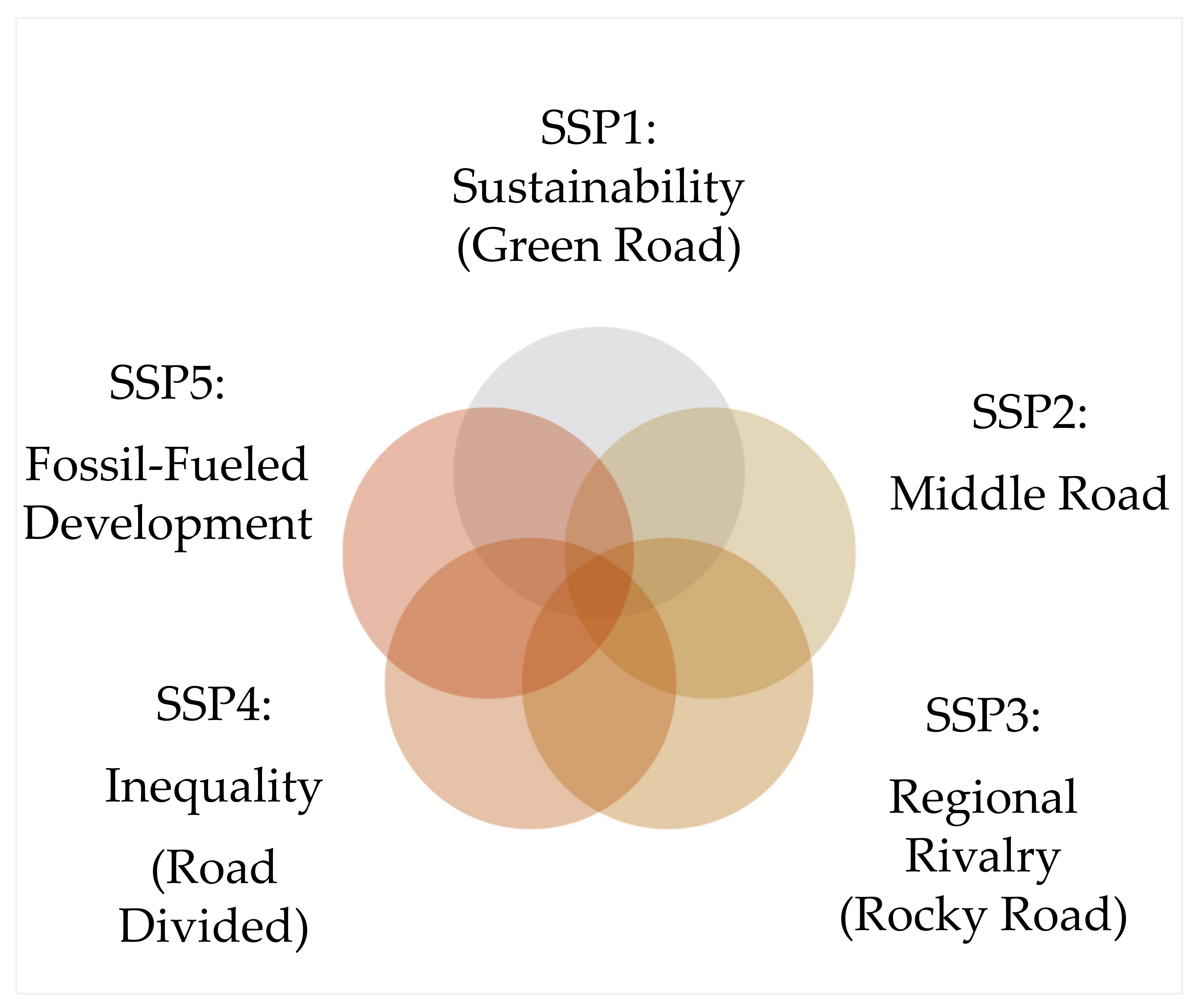

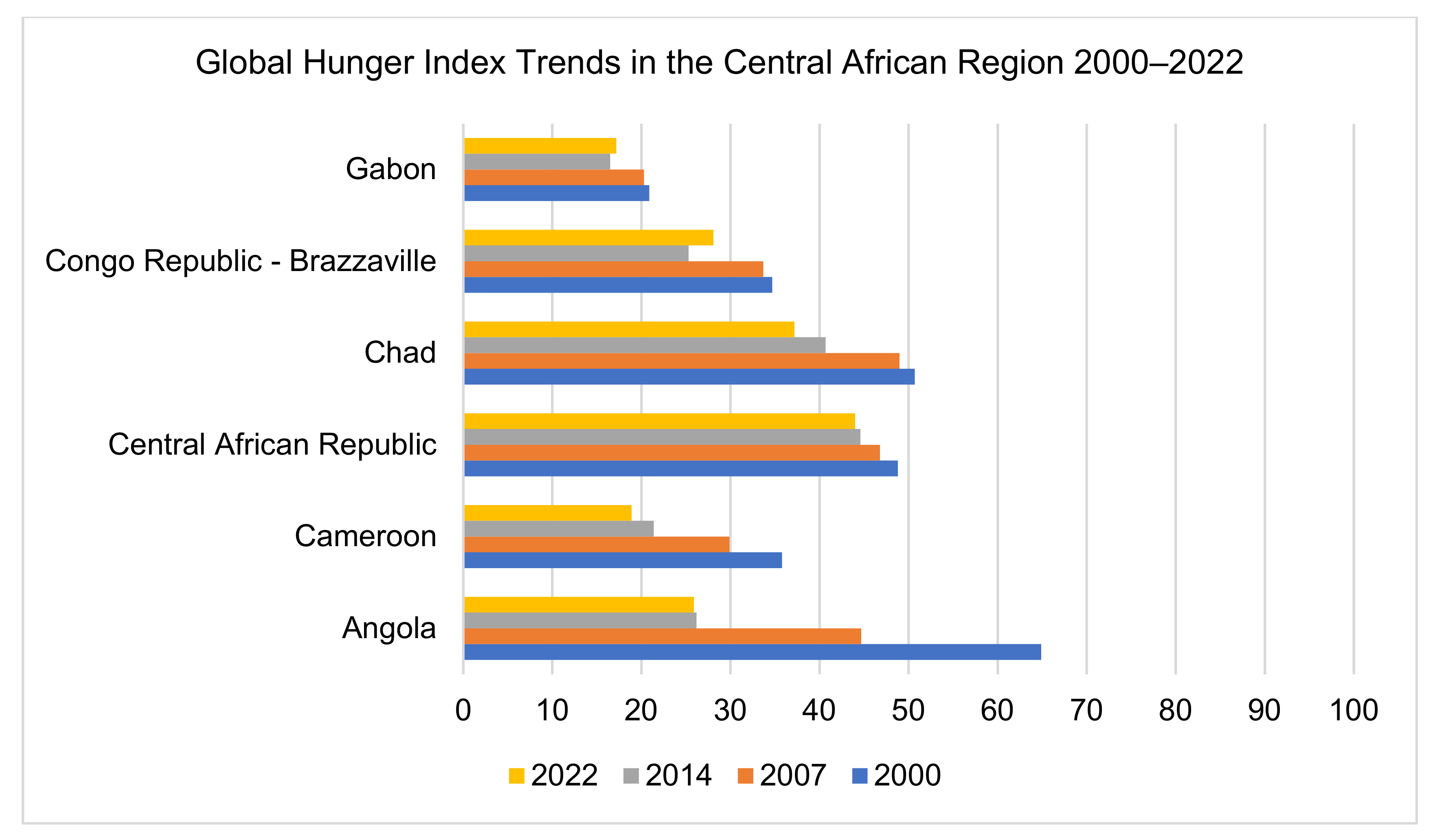
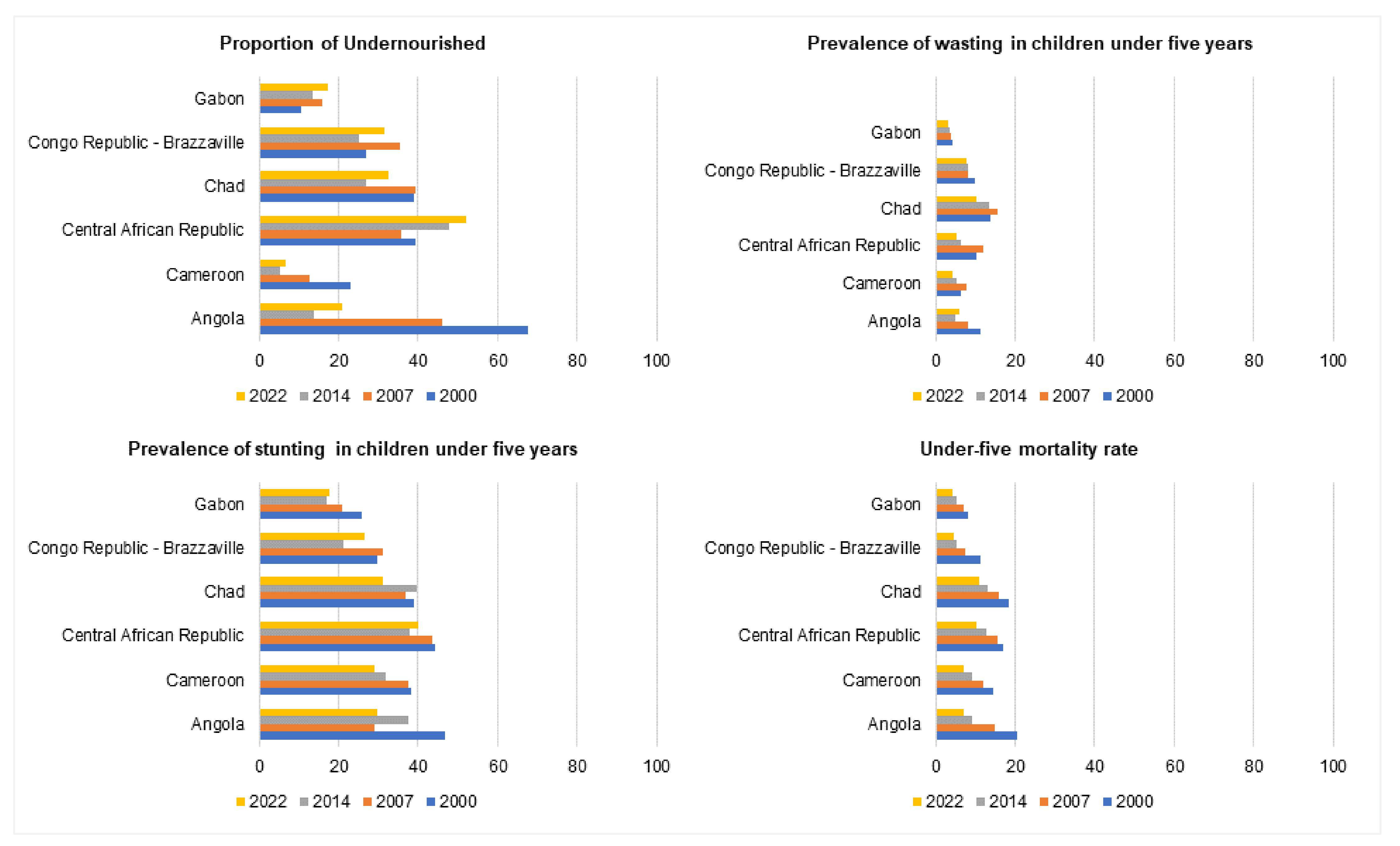
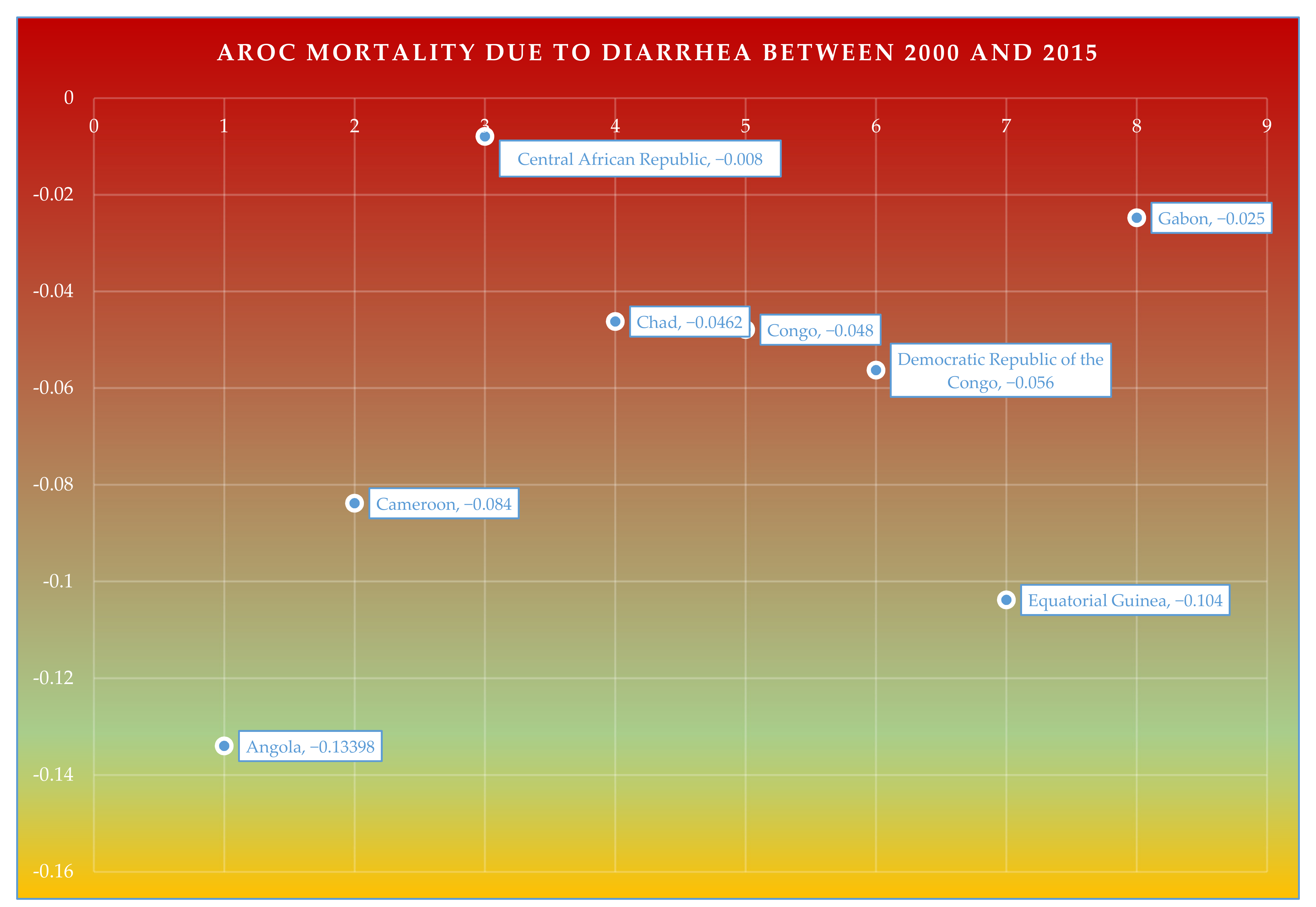
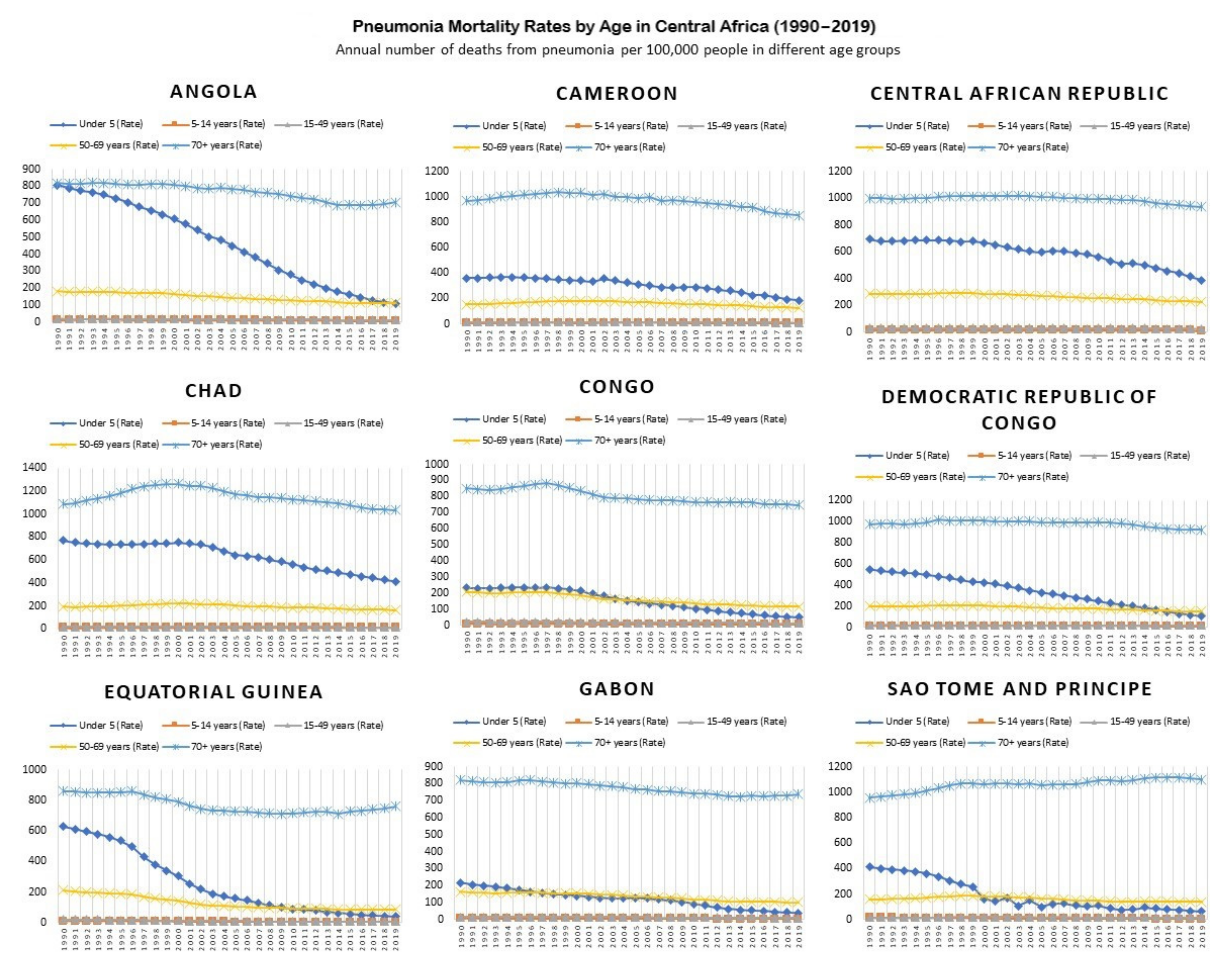
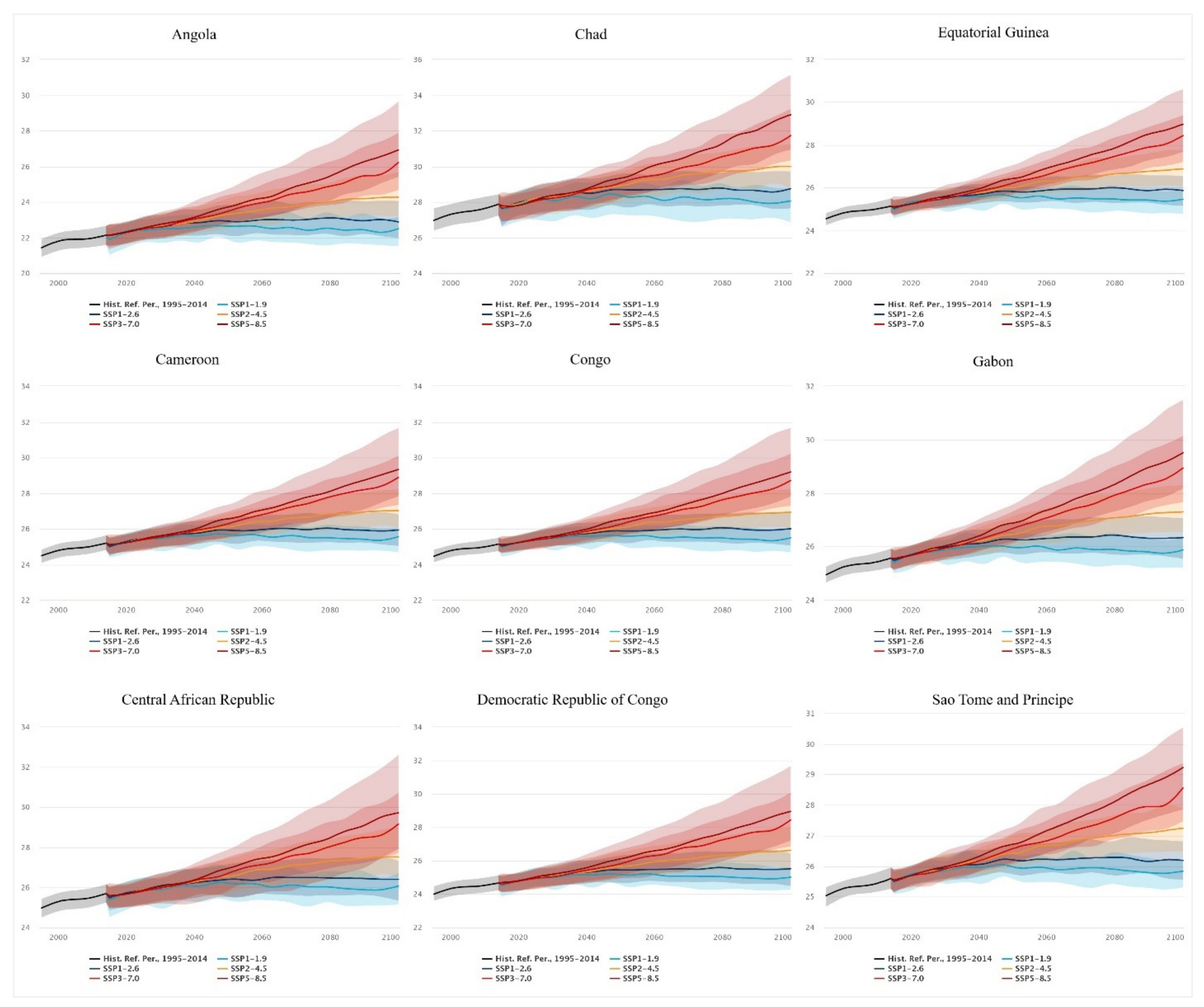
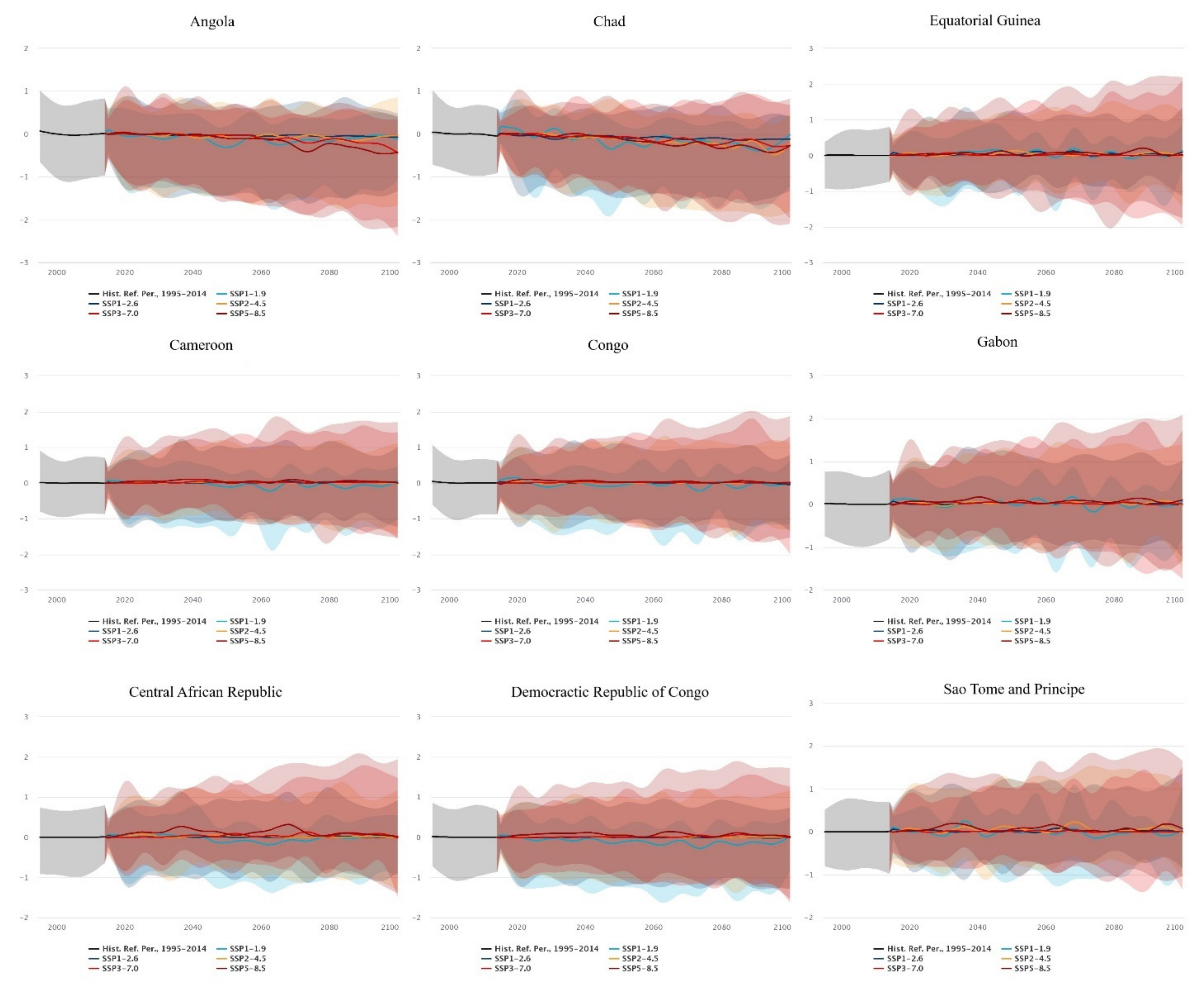
| No. | Database/Dataset Pool | Identifier |
|---|---|---|
| 1 | IPC country analysis | https://www.ipcinfo.org/ipc-country-analysis/en/ (accessed on 3 November 2022) |
| 2 | Concern Worldwide and Welthungerhilfe | https://www.globalhungerindex.org/trends.html (accessed on 3 November 2022) |
| 3 | Institute for Health Metrics and Evaluation, Global Burden of Disease | Institute for Health Metrics and Evaluation (IHME): Africa Under-5 Diarrhea Incidence, Prevalence, and Mortality Geospatial Estimates 2000–2015 |
| 4 | Global Burden of Disease Collaborative Network | Roth, G.A. Global Burden of Disease Collaborative Network. Global Burden of Disease Study 2017 (GBD 2017) Results |
| 5 | Survey data | Censuses, household, and country-specific survey series (Multiple Cluster Survey, MICS; Demographic and Health Survey, DHS) |
| 6 | The World Bank | https://climateknowledgeportal.worldbank.org/ (accessed on 3 November 2022) |
| SSP | Scenario | Estimated Warming (2041–2060) | Estimated Warming (2081–2100) | Very Likely Range in °C (2081–2100) |
|---|---|---|---|---|
| SSP1–1.9 | Very low GHG emissions: CO2 emissions cut to net zero around 2050 | 1.6 °C | 1.4 °C | 1.0–1.8 |
| SSP1–2.6 | Low GHG emissions: CO2 emissions cut to net zero around 2075 | 1.7 °C | 1.8 °C | 1.3–2.4 |
| SSP2–4.5 | Intermediate GHG emissions: CO2 emissions around current levels until 2050, then falling but not reaching net zero by 2100 | 2.0 °C | 2.7 °C | 2.1–3.5 |
| SSP3–7.0 | High GHG emissions: CO2 emissions double by 2100 | 2.1 °C | 3.6 °C | 2.8–4.6 |
| SSP5–8.5 | Very high GHG emissions: CO2 emissions triple by 2075 | 2.4 °C | 4.4 °C | 3.3–5.7 |
| Input Variables | Monthly Air Temperature and Precipitation Data Was Used |
|---|---|
| Application | SPEI was primarily used to both monitor and identify conditions linked with drought impacts |
| Key Resources | SPEI code (http://spei.csic.es/, accessed on 3 November 2022) by the Consejo Superior de Investigaciones Científicas (CSIC) *; Flood and Drought Portal by GEF, UN Environment, IWA, and DHI (http://www.flooddroughtmonitor.com/ib, accessed on 3 November 2022) |
Disclaimer/Publisher’s Note: The statements, opinions and data contained in all publications are solely those of the individual author(s) and contributor(s) and not of MDPI and/or the editor(s). MDPI and/or the editor(s) disclaim responsibility for any injury to people or property resulting from any ideas, methods, instructions or products referred to in the content. |
© 2023 by the authors. Licensee MDPI, Basel, Switzerland. This article is an open access article distributed under the terms and conditions of the Creative Commons Attribution (CC BY) license (https://creativecommons.org/licenses/by/4.0/).
Share and Cite
Hassan, M.; Saif, K.; Ijaz, M.S.; Sarfraz, Z.; Sarfraz, A.; Robles-Velasco, K.; Cherrez-Ojeda, I. Mean Temperature and Drought Projections in Central Africa: A Population-Based Study of Food Insecurity, Childhood Malnutrition and Mortality, and Infectious Disease. Int. J. Environ. Res. Public Health 2023, 20, 2697. https://doi.org/10.3390/ijerph20032697
Hassan M, Saif K, Ijaz MS, Sarfraz Z, Sarfraz A, Robles-Velasco K, Cherrez-Ojeda I. Mean Temperature and Drought Projections in Central Africa: A Population-Based Study of Food Insecurity, Childhood Malnutrition and Mortality, and Infectious Disease. International Journal of Environmental Research and Public Health. 2023; 20(3):2697. https://doi.org/10.3390/ijerph20032697
Chicago/Turabian StyleHassan, Munum, Kinza Saif, Muhammad Saad Ijaz, Zouina Sarfraz, Azza Sarfraz, Karla Robles-Velasco, and Ivan Cherrez-Ojeda. 2023. "Mean Temperature and Drought Projections in Central Africa: A Population-Based Study of Food Insecurity, Childhood Malnutrition and Mortality, and Infectious Disease" International Journal of Environmental Research and Public Health 20, no. 3: 2697. https://doi.org/10.3390/ijerph20032697
APA StyleHassan, M., Saif, K., Ijaz, M. S., Sarfraz, Z., Sarfraz, A., Robles-Velasco, K., & Cherrez-Ojeda, I. (2023). Mean Temperature and Drought Projections in Central Africa: A Population-Based Study of Food Insecurity, Childhood Malnutrition and Mortality, and Infectious Disease. International Journal of Environmental Research and Public Health, 20(3), 2697. https://doi.org/10.3390/ijerph20032697







